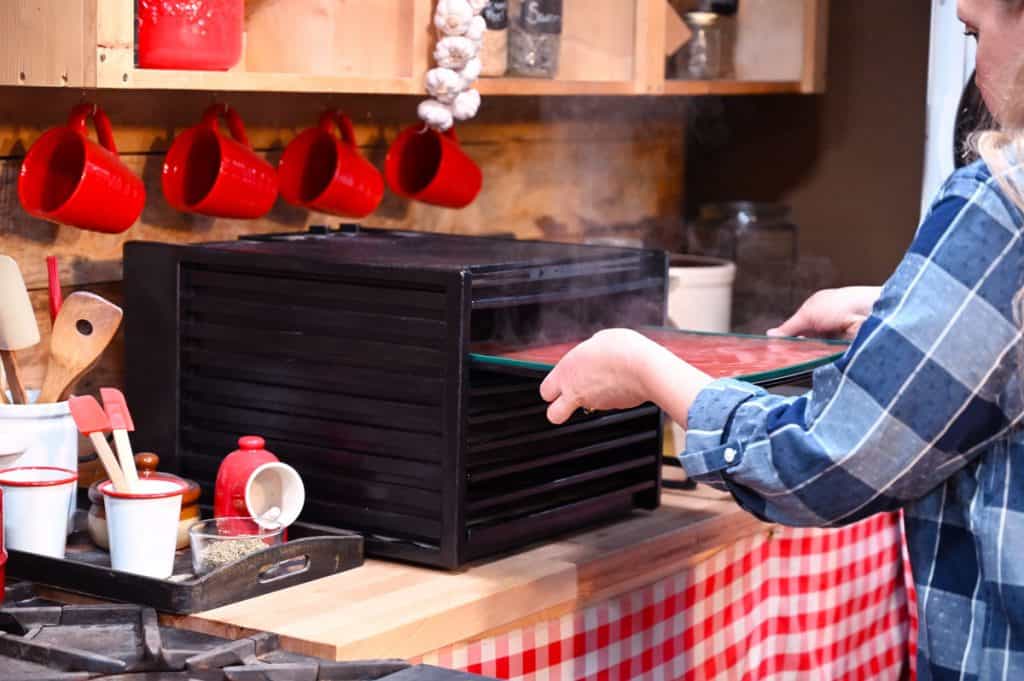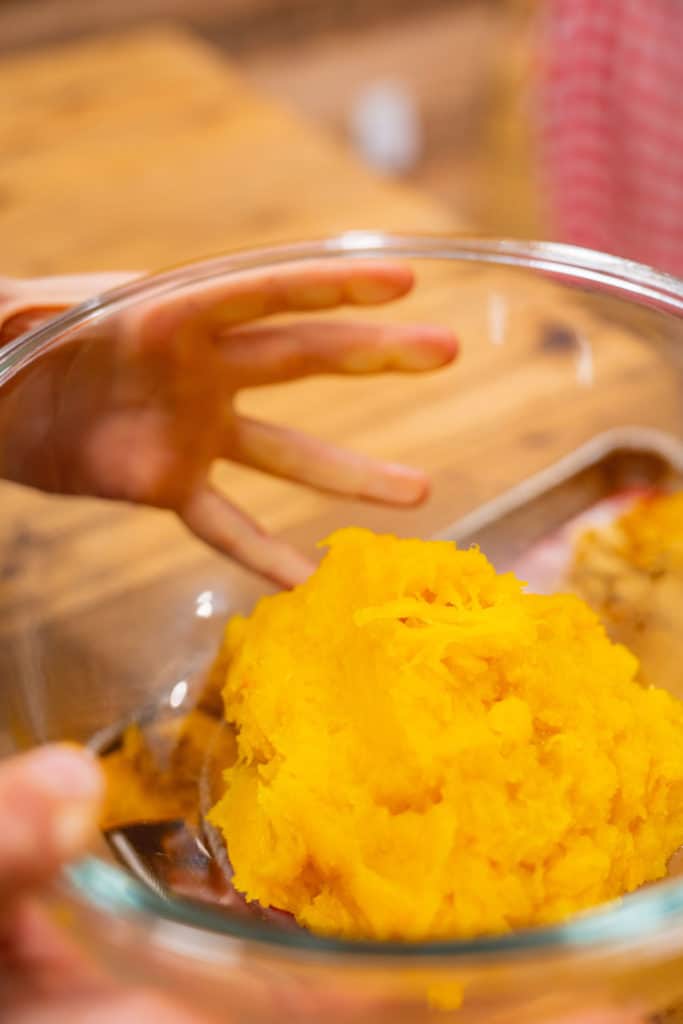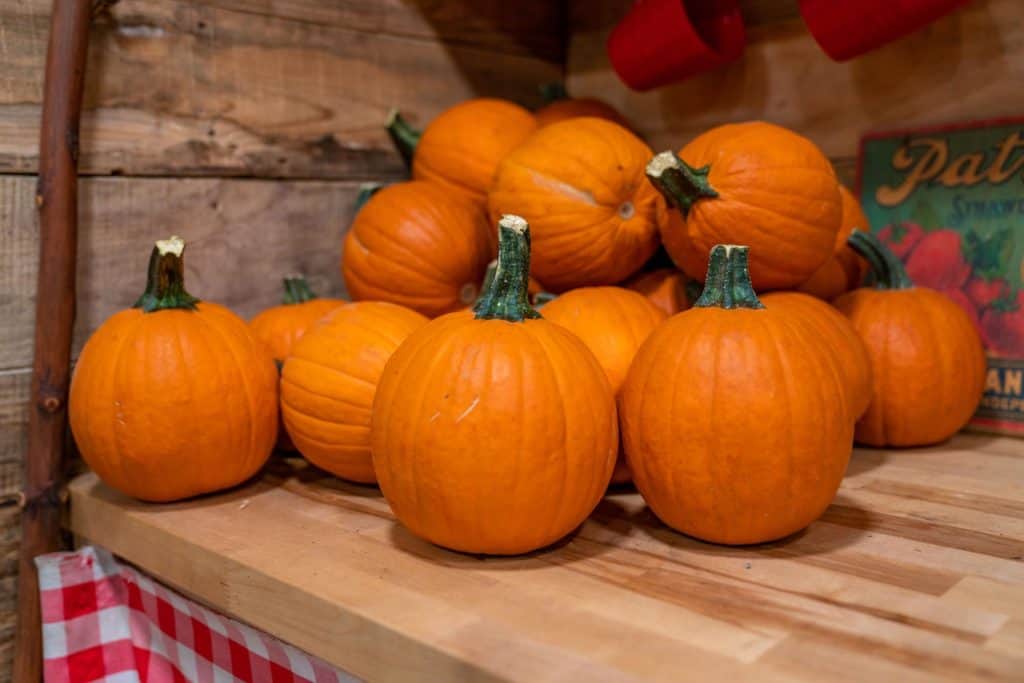Make fruit leather out of a real pumpkin! This organic apple and pumpkin fruit leather recipe is naturally sweetened with maple syrup and has the perfect amount of pumpkin pie spice. Your kids will love these in their lunchboxes, and you’ll love them as a treat, too!

Why I Love Pumpkin Fruit Leather
Making pumpkin puree for from-scratch pumpkin pie and pumpkin bread never gets old, but I like to add diversity to my preservation methods. I could pressure-can pumpkin, but it’s not my favorite way to preserve it.
Dehydrating foods is another method of preservation I use, and during the preservation season, my dehydrator is humming along to make everything from batches of dehydrated tomatoes to DIY greens powder and even drying herbs to make my own seasonings, like homemade celery salt, DIY onion powder, and homemade garlic salt.
My children love it when we use the dehydrator to make this easy strawberry fruit leather recipe, so making pumpkin fruit leather was an experiment worth trying. The results were a hit, and it has become one of our staple preservation methods for pumpkins.

Is Homemade Fruit Leather Healthy
Marketing will lead you to believe that commercially produced fruit leathers are a healthy snack, but taking a look at the ingredient list can leave you feeling disappointed.
The most popular fruit roll on the market has corn syrup, dried corn syrup, and sugar as the first three ingredients! Not to mention artificial colors, flavors, preservatives, and because it’s a dehydrated product, a concentration of any pesticidal residue from what fruit is actually in the product. No thanks!
When you make your own fruit leather, you can choose organic ingredients and make a naturally sweetened pumpkin treat without all the junk.

Supplies Needed
- Large Bowl – Use at least a 3-quart mixing bowl to incorporate all of your ingredients.
- Whisk – A fork can also be used for mixing.
- Parchment Paper – I recommend using petroleum-free parchment paper made by If You Care and found at Azure Standard. Homesteading Hack: If you’re a first-time Azure Standard customer, use coupon code “HOMESTEADINGFAMILY15” at checkout for 15% off your order of $100 or more!A more sustainable option is using a silicon mat. I recommend these fruit leather sheets made by RawNori.
- Dehydrator – I use and recommend the Excalibur Dehydrator, but if you do not have a dehydrator, you can also use an oven set at 175°F and a baking sheet.
- Storage Container – I recommend using glass Mason jars, but any container with an airtight seal will work.

Ingredients Needed
- Pumpkin Puree – You can use all pumpkin puree or substitute up to 1 cup unsweetened applesauce.
- Maple Syrup – Honey can also be used, but honey is sweeter, so use less.
- Pumpkin Pie Spice – You can make your own pumpkin pie spice by mixing 4 teaspoons cinnamon, 2 teaspoons ground ginger, 1⁄2 teaspoon each ground cloves and nutmeg. Combine ingredients well and store in a small jar or shaker bottle.
- Unsweetened Coconut Flakes – Coconut is optional but is a nice addition.
- Ground Cinnamon – Save this additional cinnamon for dusting finished fruit leather at the end.

How to Make Pumpkin Fruit Leather Step-by-Step
- Stir pumpkin puree, applesauce (if using), maple syrup (or honey), and pumpkin pie spice together in a bowl with a whisk or a fork until smooth.
- Line dehydrator trays (or your baking sheet) with parchment paper. Drop rounded tablespoonfuls of pumpkin mixture on the parchment paper in 1/4” thick round shapes like cookies.
- Sprinkle a little coconut on top, optional.
- Dry in a dehydrator set at 130°F (55°C) until completely dry. The amount of time this takes depends on your dehydrator. It could take 10-12 hours. If using the oven method, bake in a preheated oven at 175°F for 4-5 hours.
- To test for doneness, pick up one piece and bend it. It should be dry and flexible, with no pockets of moisture. Remove the pieces that are dry and let them cool in an open bowl. Continue drying the remaining pieces of fruit leather until they, too, are done. It goes quicker at the end, so check those last few every 15 minutes.
- Dust completely cooled pumpkin leather with cinnamon to keep it from sticking together, and store it in an airtight container.

How can I tell if my fruit leather is done?
Your pumpkin fruit leather should feel dry and pliable. Place your fully cooled pieces in a jar and store them in a dark cupboard for a week, checking daily. If you see droplets of moisture form inside the jar, it means your fruit leather is not quite dry enough, and you’ll need to take the fruit leather out of the jar, put them back on the dehydrator trays, and give them another hour or two to complete drying.
How long does fruit leather last?
Properly dried pumpkin fruit leather is shelf-stable at room temperature. You can store the jar in your pantry or a dark cupboard for 6-12 months, but they probably won’t last that long with kids in the house!
Why is my fruit leather crunchy?
The most common reason for crunchy fruit leather is overdrying it. When spooning your puree onto the tray, try drawing a thicker layer out to the edges, leaving it a bit thinner in the center to prevent crispy edges and promote even drying.
The texture of your puree is also critical. It should be smooth and evenly mixed without pockets of water.

In the Homestead Magazine
This recipe was featured in the Pumpkins and Winter Squash issue of In the Homestead Kitchen Magazine, where together we fill our pantries, feed our families, and change our culture.
To spend less time on your homestead and more time on the things you love, you can subscribe here.
Each month, you will receive access to the latest publication with a bonus video library to take the confusion out of homesteading so you can start THRIVING. Subscribe today and gain the skills, knowledge, and confidence you need to master your homestead kitchen.

Other Articles You May Enjoy
- Homemade Pumpkin Pie Recipe
- How to Make Pumpkin Puree From Scratch
- Pressure Canning Pumpkin the Easy Way
- Easy Fruit Leather Recipe – How to Make Fruit Leather That’s Soft & Chewy
- Preservation 101: Dehydrating Food
- Foods You Should Not Dehydrate
- Dehydrating Tomatoes – Three Easy Ways
- Homemade Garlic Salt (Easier & Better Than Store-Bought)
- Preserving Caramelized Onions (Balsamic Onions)
- DIY Homemade Greens Powder: Preserve Your Garden Greens
- How to Make Onion Powder From Scratch (Easy DIY Recipe)
- Easy Homemade Celery Salt

Pumpkin Fruit Leather
Equipment
- Dehydrator or oven set to 175°F
Ingredients
- 2 cup pumpkin puree or 1 cup pumpkin and 1 cup applesauce
- 1/4 cup maple syrup up to 1/2 cup, to taste
- 1 teaspoon pumpkin pie spice up to 2 teaspoons, to taste
- unsweetened coconut flakes
- ground cinnamon
Instructions
- Stir pumpkin puree, applesauce (if using), maple syrup (or honey), and pumpkin pie spice together in a bowl with a whisk or a fork until smooth.
- Line dehydrator trays (or your baking sheet) with parchment paper. Drop rounded tablespoonfuls of pumpkin mixture on the parchment paper in 1/4” thick round shapes like cookies.
- Sprinkle a little coconut on top, optional.
- Dry in a dehydrator set at 130°F (55°C) until completely dry. The amount of time this takes depends on your dehydrator. It could take 10-12 hours. If using the oven method, bake in a preheated oven at 175°F for 4-5 hours.
- To test for doneness, pick up one piece and bend it. It should be dry and flexible, with no pockets of moisture. Remove the pieces that are dry and let them cool in an open bowl. Continue drying the remaining pieces of fruit leather until they, too, are done. It goes quicker at the end, so check those last few every 15 minutes.
- Dust completely cooled pumpkin leather with cinnamon to keep it from sticking together, and store it in an airtight container.


















